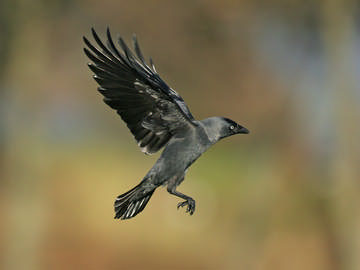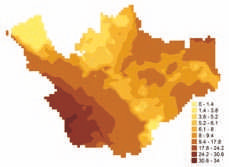
Jackdaw © Steve Round
This Atlas indicates that Jackdaws have increased substantially across the county. They were found in 61 more tetrads than during the 1978-84 fieldwork period for our First Atlas, and the number of tetrads with confirmed breeding went up from 303 to 388. They are still quite sparsely distributed in Wirral, where the ‘change’ map indicates that they have been lost from a number of tetrads, and along the Mersey valley, a lack that is mirrored in adjacent counties to the north of the Mersey. Jackdaws are missing from a handful of the squares at highest altitude in the east of Cheshire. Throughout the rest of the county they are now almost ubiquitous, having spread to fill in most of the gaps from twenty years ago. The abundance map shows that they are found at highest densities in the agricultural southwest of the county.
Most of the proof of breeding came from observers seeing birds going to or from their nests, for which they use any sort of large hole, filling it with lots of sticks, often leaving some poking out. Observers in 33 tetrads noted Jackdaws nesting in chimneys, and in tree holes in a further 21, with one pair near Crewe (SJ75H) feeding young in a hole in an ash tree about one metre away from an active nest containing noisy Great Spotted Woodpecker chicks. They can make a nuisance of themselves by occupying nest boxes intended for Barn Owls, and nest widely in church spires. They often form small colonies, with at least eight occupied nests in chimneys of Westwood Grange Country Club, Thornton Hough (SJ27Z) and at least fifty pairs breeding in Dunham Park (SJ78I). The association with buildings shows up in the analysis of habitat codes, with 42% of records in human sites, 34% in farmland and 21% in woodland.

Jackdaw abundance.
The Jackdaw’s diet is very varied, with farmland insects, usually picked from amongst the grass or crops rather than from probing in the ground, often making up the majority. Many birds in woodland feed their chicks on caterpillars, and they are surprisingly agile and adept at clinging on to thin branches in the tree canopy. They eat a lot of vegetable matter, plants and seeds, and will scavenge for almost anything else including carrion (Coombs 1978). These generalist feeding habits allow it to exploit diverse and ephemeral food resources, and must have helped it to ride out changes in agricultural practice. BTO figures show that their breeding total nationally rose by 30% in the twenty years from 1984. According to the analysis of BBS transects in Cheshire and Wirral, their breeding population in the county in 2004-05 was 32,610 birds (21,960-43,250), an average of 58 birds per tetrad in which they were found.
Sponsored by John Davies

